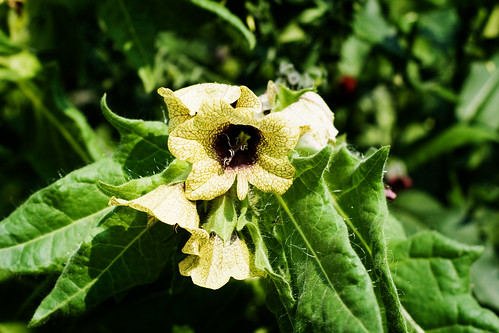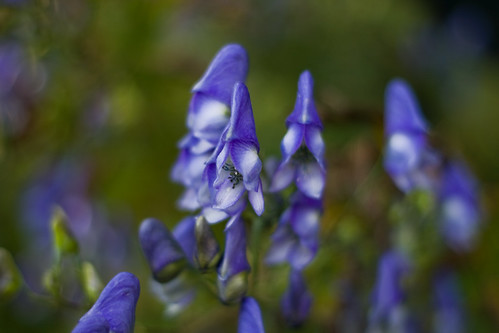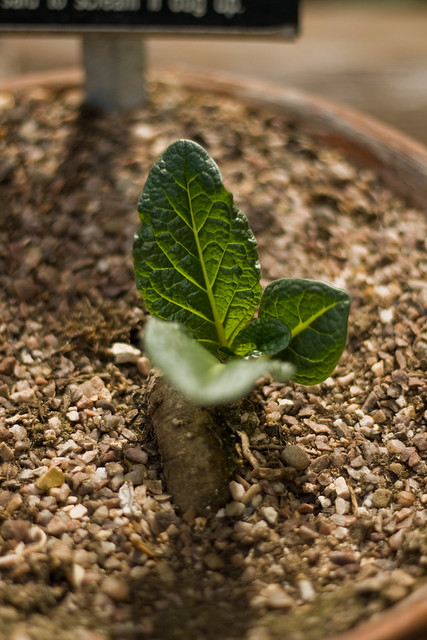One of the enduring images of witches is the lone figure, hunched over a bubbling cauldron, a handful of roots in one hand, and a questionable bundle of ingredients in the other. We’ve basically got Shakespeare to thank for that.
“Hubble bubble, boil and trouble,”and so on.
And such an image nearly always involves plants of some kind. We’ve looked at the folklore of toxic plants before. But there are far more plants than the three we looked at before.
So we’re focusing on 3 essential plants that you might find in a witch’s pantry. I give you henbane, wolfsbane
Henbane
Sometimes also known as black nightshade or devil’s eye, henbane is highly toxic. It’s so poisonous that even the smell of its flowers produces giddiness.
I can attest to that. I felt distinctly nauseous when I smelled it in the Alnwick Garden!

Henbane (hyoscyamus niger) is actually a member of the same family as deadly nightshade (and potatoes!). The ‘bane’ part of its name comes from an old English word meaning ‘death’. Apparently hens were particularly susceptible to dying after eating its seeds.
According to the Poison Garden website, the seed heads look like a jawbone. So doctors used henbane to ease the pain of toothache. This use mostly comes from the belief that worms in the tooth caused the pain. One ‘cure’ involved burning a mixture of frankincense, henbane and onion seeds (Kanner 1935: 125). The patient funnelled the smoke towards the affected tooth. The worms supposedly wriggled out of the tooth and the pain eased. (Do NOT try this at home. See a dentist instead!)

Symptoms of henbane poisoning can include hallucinations, restlessness, and dilated pupils. Many believe a distillation of henbane is the poison poured into the ear of Hamlet’s father to murder him (others think it was yew). Some believe Dr Crippen used a pharmaceutical version of henbane to poison his wife in 1910.
So why is it useful to witches?
Its hallucinatory properties lead some to believe witches used henbane in the famous ‘witch’s ointment‘. Such an ointment allegedly enabled them to fly. Deadly nightshade and wolfsbane are other essential ingredients.

Niall Mac Coitir notes a Welsh belief that children who fell asleep near henbane would never wake up again (2015: 252). But he also relates a weird belief found in a medieval manuscript. Apparently, putting henbane on a
You might wonder what that has to do with witches. Many believed witches could turn into hares on their way to gatherings. Being able to gather suspected witches in one place would probably be quite comforting.
Some believe henbane can be used to communicate with the dead. It also sets the seal on binding spells. In Greek mythology, the dead wore henbane wreaths as they walked along the river Styx.
However, Scott Cunningham believes henbane can be useful in love magic. If worn, it will bring love. It will also bring rain if you burn it outside, but be wary since the fumes are poisonous (1985: 137).
If you want rain, it’s best to do the traditional British rain dance. Just set up a barbecue!
Wolfsbane
Otherwise known as monkshood (aconitum napellus) was the official poison on Ceos. Anyone who was useless to the state was poisoned.

The armies of ancient Europe and Asia also used it to poison enemy water supplies. The poison paralyses the nervous system, lowers blood pressure and eventually stops the heart.
It’s the poison of choice in the pilot episode of Forever. It also appears in AK Lakelett’s mystery novel, Remember me? (I highly recommend it, by the way).
Bizarrely, it also appears as the herb of choice to ward off the Count in Dracula (1931). This could relate to the old belief that vampires could turn into wolves – something more recent novels seems to have ditched in favour of feuds between vampires and werewolves.

According to Amy Stewart, the Nazis even used it to poison bullets during the Second World War! (2010: 2).
Aconite is named after Aconitus Hill, where Hercules fought Cerberus, guard dog of the Underworld. Hecate, goddess of witchcraft, pulled wolfsbane out of Cerberus’ saliva.
Interestingly, both atropine (deadly nightshade) and digitalis (foxgloves) act as antidotes to aconitine (Gillam, 2008: 4)!
So why is it useful to witches?
Because aconite is so toxic, it doesn’t really have many witchy uses, aside from flying ointment. Perhaps its deadly effects were offset by the inclusion of its antidotes.
In fact, the Romans banned its cultivation in gardens in 117AD after a spate of monkshood murders! (Baker, 2011: 9)
Ancient Greek hunters dipped their arrows in aconite when hunting wolves. Hence ‘wolfsbane’. So it sometimes appears as either a cure for lycanthropy, or a means of protecting against werewolves.
Earthwitchery.com also cite it as a protective plant. It’s particularly useful for the invocation of Hecate.
Mandrake
Mandrake (mandragora officinarum) is another member of the solanaceae family, alongside henbane and deadly nightshade.
Ernst and Johanna Lehner cite the mandrake as “the oldest magic plant in botanical history”, noting its appearance in the Book of Genesis and Greek mythology (2003 [1960]: 91). Many think Circe’s potions contained mandrake. They also claim “[i]t was common knowledge in medieval time that the mandrake grew under the gallows from the dripping semen of hanged men” (2003 [1960]: 91).
Some even think mandrake only grows in the dark.

It also has a fascinating history. The root is known as both the Root of Life and the Divine Root. Its unusual, almost human shape probably helped with the name.
At one time, people prized the roots more than gold!
Roman physicians used its anaesthetic effects to perform complicated surgery. An excavation of a medieval hospital near Lauder unearthed mandrake seeds.
The most famous tale relates to the belief that the plant shrieks when uprooted. Anyone who hears the shriek dies. The ancients tied dogs to the plants, then spurred the dogs to run. They pulled up the plant while the humans remained out of earshot. (Or, do as they do at Hogwarts and wear ear muffs)

Jacqueline Simpson points out the first ‘hand of glory’ mentioned in English was actually the mandrake root (2000: 165). People kept it “as a charm to make coins multiply” (2000: 165). The hand of glory now means something else. But it’s interesting that people believed the mandrake grew below the gallows. They also believed you could cut the hand from a hanged criminal to make a hand of glory. Funny how they’re both linked to the folklore of the gallows.
So why is it useful to witches?
Many believed the root grew within the power of dark earth spirits. Some even believe the root housed a witch’s familiar! (Gillam, 2008: 20). Others think witches used mandrake root in their flying ointment.
People believed the root could rejuvenate lost youth. It also induced feelings of love and affection. Clairvoyants
Walter Lewis and Memory Elvin-Lewis note the link between mandrake and “the doctrine of signatures”, which meant that you used the plant to treat conditions affecting the body part it resembled (2003: 711).

So in the case of mandrake, “the more stout, robust, male-looking roots would be appropriate for certain masculine diseases and difficulties” (2003: 711). Other parts of the plant were used for problems affecting women.
Mandrake also acts as a powerful sedative. In c.200BC, Hannibal left drugged wine, laced with mandrake, in the city of Carthage. The local African warriors drank the wine and fell into a stupor. Hannibal’s forces retook the city and slew the sleeping warriors.
In Romeo and Juliet, mandrake laces Juliet’s sleeping potion (Stewart, 2010: 106).
So while it’s not as immediately toxic as wolfsbane, it still isn’t something to use lightly!
So there we have it! 3 infamous toxic plants – and what witches might have done with them!
References
- Baker, Margaret (2011) Discovering the Folklore of Plants, 3rd edition, Oxford: Shire Classics.
- Gillam, Frederick (2008) Poisonous Plants in Great Britain, Glastonbury: Wooden Books.
- Kanner, Leo (1935), Folklore of the Teeth, New York: MacMillan.
- Lehner, Ernst and Johanna Lehner (2003 [1960]), Folklore and Symbolism of Flowers, Plants and Trees, New York: Dover.
- Lewis, Walter H. and Memory P. F. Elvin-Lewis (2003), Medical Botany: Plants Affecting Human Health, second edition, Hoboken, NJ: John Wiley & Sons.
- Mac Coitir, Niall (2015), Ireland’s Wild Plants – Myths, Legends & Folklore, Cork: Collins Press.
- Simpson, Jacqueline and Stephen Roud (2000), A Dictionary of English Folklore, Oxford: Oxford University Press.
- Stewart, Amy (2010) Wicked Plants: The A-Z of Plants that kill, maim, intoxicate and otherwise offend, London: Timber Press.
Nutty about folklore and want more?
Add your email below and get these posts in your inbox every week.
You'll also get my 5-step guide to protecting your home using folklore!







Hen bane-you may need to look at the word hen-still used in Scotland as a term of endearment as in ‘Old thing’-Hen in Welsh is the word for ‘old’.So in Early English that was in use before hens(ie chickens)were introduced to Britain just a thought
Nice information, Thanks!
I am breeding Thousand’s of mandrakes in my nursery in France (National Collection Status).
Any advice on mandrake cultivation, please ask 🙂